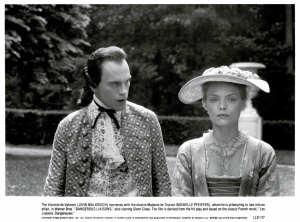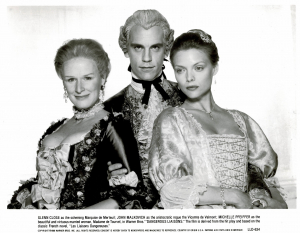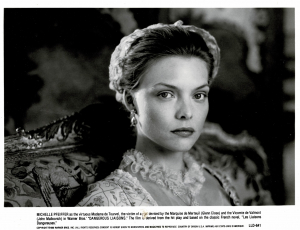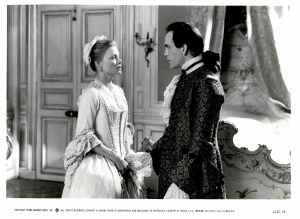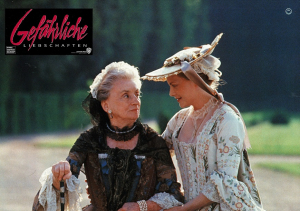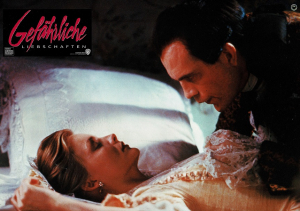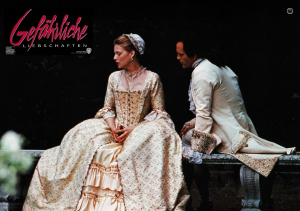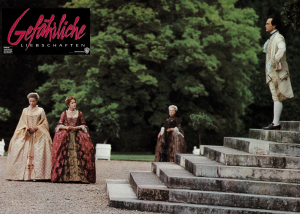Dangerous Liaisons
“DANGEROUS LIAISONS”
– Production Information –
“If the adventures here portrayed have
any basis whatsoever in .truth, I feel
sure that they Can:only-have occurred in
some other place and at some other time.”
Choderlos de Laclos
1741 – 1803
If he who lives by the sword also dies by the sword, then what of the man who lives by the powers of seduction?
Choderlos de Laclos first posed this question in his erotic novel, Les Liaisons Dangereuses. Ever since, readers of the French classic have been fascinated, charmed and astonished by the nimble sexual gamesmanship of the beautiful Marquise de Merteuil and her ex-lover, the Vicomte de Valmont.
These two may be the most ingenious players ever to take the field in the age-old war between the sexes. But be warned before you get involved with them: They take no prisoners.
In their latest incarnation, WarnerBros.’ screen version of Les Liaisons Dangereuses, entitled “Dangerous Liaisons,” Merteuil and Valmont are played by two of the most dexterous stars of the American screen, Glenn Close and John Malkovich, under the direction of Stephen Frears, whose previous films include “Prick Up Your Ears” and “My Beautiful Laundrette.”
The film is an adaptation of the celebrated play produced by the Royal Shakespeare Company that opened in New York in 1986 and stunned Broadway audiences with a dazzling series of psychological twists and a shocking resolution. The screenplay Is by playwright Christopher Hampton.
“Dangerous Liaisons” is set among the French aristocracy just prior to the French Revolution, a time of legendary decadence. The corseted .and perfumed characters are wealthy beyond reckoning and fully dedicated to the pursuit of their own pleasure. Yet they, learn that human emotions are not easily trifled with. As it spins a timeless plot of labyrinthine sexual intrigue, “Dangerous Liaisons” delves into the most private reaches of the psyche.
The complications begin when the exquisitely coiffed Marquise de Merteuil (GLENN CLOSE) asks an urgent favor of the roguish Vicomte de Valmont (JOHN MALKOVICH). She is
quietly seething with jealousy because her most recent lover, M. le Comte de Bastide, has left her to marry a virgin. Perhaps Valmont would be kind enough to help Merteuil take her revenge on-Bastide by seducing and deflowering Bastide’s
intended bride, the beautiful young Cecile de Volanges (UMA THURMAN), daughter of Madame de Volanges (SWOOSIE KURTZ).
But the treacherous-Merteuil quiCkly learns that Valmont, her intended pawn in this bizarre scheme, has other plans. Valmont has set his sights upon the much more challenging seduction of a beautiful married woman, Madame de Tourvel (MICHELLE PFEIFFER), a member of the bourgeoisie who believes deeply in the sanctity of marriage. For Valmont to succeed with the virtuous Madame de Tourvel will be his Most prestigious seduction ever.
Madame Tourvel is staying, conveniently, at the country estate of Madame de RosemOnde (MILDRED NATWICK), the Vicomte’s aunt. Valmont has arranged an invitation for himself to stay with his aunt. Amused by Valmont’s plan., Merteuil promises to reward him. with .one-night of love should he succeed in his carnal quest.
Still determined to punish Bastide through Cecile, Merteuil turns to a handsome and shy young music teacher, Chevalier Danceny (KEANU. REEVES), arranging for Cecile to. take lessons. with him. Unwittingly, Danoeny falls for. Merteuil’s scheme and writes impassioned love letters to the young virgin, but the relationship,fails to become physical. Frustrated, Merteuil informs Cecile’s mother of the dangerous flirtation and suggests that Cecile be removed from harm’s way–to the safe environment of Madame de Rosemonde’s country estate. It .is a shrewd tactic that will place the young girl within striking distance of the rake Valmont.
Now the seducer is free to wage carnal battle on two fronts. When Valmont is spurned by the unassailable Tourvel, he turns his insatiable desire upon the inexperienced Cecile, who is easily manipulated by him. This achievement is quickly surpassed when Valmont finally manages to batter down the resistance of the more mature Tourvel. But along with Valmont’s triumph there comesan unexpected complication: he violates the strict code of the dedicated seducer that he and
Merteuil live .by, committing the ultimate sin of actually falling in love with Tourvel. This emotional weakness can only result in tragedy-for all…
Warner Bros. presents a Lorimar Film Entertainment Picture, an NFH Limited Production, starring Glenn Close, John Malkovich and Michelle Pfeiffer in “Dangerous Liaisons.”
The Warner Bros release also stars Swoosie Kurtz, Keanu Reeves, Mildred Natwick-end Uma Thurman. The film is directed by Stephen Frears and produced by Norma Heyman and Hank Moonjean, from a screenplay by Christopher Hampton, based on the play by Hampton, adapted from the novel “Les Liaisons Dangereuses” by Choderloy de Laclos. The film editor was Mick Audsley; director of photography was Philippe Rousselot; production designer was Stuart Craig; costume designer was James Acheson.
Music is by George Fenton.
About the Production…
Despite a scandalous reputation and frequent bannings, Choderlos de Laclos’ erotic and psychological masterpiece, Les Liaisons Dangereuses has fired the imagination of readers since its publication in 1782.
One reader who succumbed to the book’s spell was British playwright-Christopher Hampton. “I loved the book and used to re-read it often,” Hampton recalls. “It’s – one of the most profound analyses ever made of love and sex,–and the difference between them.”
Hampton long harbored an ambition to adapt Les Liaisons Dangereuses for ,the stage.. He got his chance when he was commissioned in 1984 by the Royal Shakespeare Company to write anything he chose. The RSC was a bit surprised when he delivered “Les Liaisons Dangereuses” since the Company had staged a dramatization of the novel in the 1960s.
The London production of Les Liaisons Dangereuses” won the 1986 Olivier Award, the British equivalent of Broadway’s Tony, and is-stiil running after 800 performances.
The RSC’s Broadway production was nominated for seven Tonys.
The play has since overcome French doubts about an Englishman’s adaptation of a French classic to dazzle audiences in Paris and has won acclaim on other stages around the world–in Japan, Italy, Mexico and Los Angeles, among others.
“The reason it’s been so successful,” the playwright says modestly, “is because the book’s story is so strong.
You don’t know what’s going to happen next. It also seems to relate very strongly to today. Recently, both in England and America, institutionalized selfishness has been encouraged, so the heartlessness of the characters’ behavior seems
to strike a chord. People recognize the greed–not for money, since the characters are unbelievably rich–but for power.”
Immediately on the heels of the play’s triumphant London premiere, Christopher Hampton received offers from a dozen film producers who recognized the play’s tremendous screen potential. He ultimately chose to work with Norma Heyman, who formed NFH Films and made her own debut as a producer with a Hampton screenplay, “Beyond the Limit,” starring Michael Caine, Richard Gere and Bob Hoskins.
“As soon as I saw the play I.knew I had to make this film,” Heyman says. “It had everything I love best and search for in a potential film; romance, humor, passion, extraordinary irony, and in the end, it’s a very moral tale.”
Joining forces with producer Hank Moonjean, a 34-year Hollywood veteran, Heyman and Hampton sought and obtained the services of the ideal director for the project: Stephen Frears. Frears is a veteran British television and film director who most recently won critical and audience plaudits for three successive movies about the tricky games lovers play: “My Beautiful Laundrette,” “Prick Up Your Ears” and “Sammy and Rosie Get Laid.” “Dangerous Liaisons” should cement Frears’ reputation as an undisputed master of the subject.
“‘Dangerous Liaisons’ has such a wonderful story,”
Frears says. “The setting may be just before the French Revolution, but it’s very modern in its treatment of romance.
People behaving badly is quite familiar.”
In addition to his growing renown as a taleted director of love stories, Frears is noted for working well with top writers. He has collaborated with Alan Bennett, Tom Stoppard, Peter Prince and Neville Smith, among others.
Frears and Christopher Hampton agreed that Hampton’s adaptation of “Les Liaisons Dangereuses” should not rely totally upon Hampton’s play, but should be drawn directly from the book.
“People tell stories in plays,” Frears explains.
“In film, you show it. Plays are always too long. Films are often too long, but it’s worse in the theatre.” Christopher Hampton agrees, “I really put the play away, started from the book again, and tried to re-think it,”
he sayst “The way you build a scene in the theatre is different, it takes more time to develop.”
The resulting screenplay for “Dangerous Liaisons” was forty minutes shorter than the play. “The story is more from the book,” says Frears. “The dialogue is from the play.”
With its rich language and complexity of emotions, “Dangerous Liaisons” presents a particular challenge to its actors. Frears decided it was essential to cast the film principally with actors trained in the theatre, who would be
comfortable with Christopher Hampton’s rich language. He also believed American actors would be an asset.
“To me, the access to the material is through the characters,” Frears explains. “The film is about people dealing with their feelings–or failing to deal with them and American actors play feelings wonderfully, especially
in close-up.”
Glenn Close was a natural choice for the Tole of Merteuil, her first movie since her triumph in “Fatal Attraction,” which marked a radical shift for Close, away from playing sympathetic heroines on screen. Merteuil, who is described in Hampton’s screenplay-as “a genuinely wicked woman,” will be her second successive screen villainess.
“Just last year everyone was calling me Goody-Two- Shoes,” the actress sighs. But Close sees a dramatic difference between Merteuil and Alex, the character she played in “Fatal Attraction.”
“That lady lost all control,” Close says. “This one is in complete control of herself–and almost everyone else!
“Merteuil is a lady I’ve always wanted to play,” Close adds, “because she’s very modern–a highly intelligent woman born in the wrong century. She really had no outlets for her brilliance except for manipulation.”
Playing opposite Close as the ultimate seducer and libertine, John Malkovich sees Valmont as an essentially tragic figure snared by his own trap.
“Valmont is born with so many advantages,” Malkovich says. “He’s intelligent, witty, clever, rich and attractive, yet he devotes himself to destruction. All this wit and drive and passion and talent and energy devoted to decadence could only have one result: revolution.”
Like Close and Malkovich, Swoosie Kurtz, who plays Madame de Volanges, came to films from an established and highly successful career in theatre. Kurtz is the winner of two Tony Awards and an Obie. Stephen Frears was able to cast even the youngest members of the company with actors who had stage experience. Keanu Reeves, who plays Chevalier Danceny, may be best known for his performance as a troubled teenager in the film “River’s Edge,” but the twenty-three- year-old Toronto native has played Shakespeare on stage.
Eighteen-year-old Uma Thurman, who plays Cecile, also has New York theatre experience.
Michelle Pfeiffer, playing the virtuous Madame de Tourvel, is the exception to Frears’s preference for classically trained stage actors. Pfeiffer’s credits are an impressive assortment of roles in a dozen movies.
“But that’s all right,” Frears says cheerfully.
“Michelle’s character, Madame de Tourvel, is from a different class, more bourgeoisie than aristocracy. It was the bourgeoisie who introduced the idea of marriage as a romantic concept rather than a business proposition, and the French Revolution was really about the rise of the bourgeoisie in the 18th Century.”
In other words, Pfeiffer’s remarkable ease in front of the cameras, and her contemporary beauty, perfectly suit the role of Tourvel a woman whose special grace is her lack of artifice.
Mildred Natwick rounded out the cast as Valmont’s elderly aunt, Madame de Rosemonde. The 83-year-old Natwick is the veteran of dozens of stage, screen and television appearances, including a number of films directed by John
Ford and Alfred Hitchcock.
“Dangerous Liaisons” was shot on location in a series of eight magnificent chateaux in the Paris vicinity. Frears made a conscious decision to play down the opulent trappings of the period to better emphasize the story’s contemporary
psychology and to shift the focus towards the characters.
Still, a French count was consulted on the finer points of 18th-century etiquette, and the actors had to dress in restrictive period clothing, including corsets, panniers
(hoop skirts that required a wide double doorway for a smooth passage) and massive wigs.
“It’s no wonder the French aristocracy needed so many servants,” Glenn Close ‘remarks. “You need help to get into these dresses. You can’t do it alone.”
“Dangerous Liaisons” boasted an impressive array of talent behind the cameras to realize the lush look of the period. Director of photography Philippe Rousselot was nominated for an Oscar for “Hope and Glory.” Production designer Stuart Craig won an Oscar for his work on -”Gandhi,” and was nominated for another for “The Mission.” James Acheson, the costume designer, received the 1988 Academy Award for his work on “The Last Emperor.”. And composer George Fenton was nominated for his score for “Gandhi:”
[/vc_column_text][/vc_column][/vc_row]
About the Cast…
GLENN CLOSE (Marquise de Merteuil) received her fourth Oscar nomination in 1988 for her riveting performance as Michael Douglas’ spurned lover in “Fatal Attraction.” She received three nominations for her first three film appearances,
which were in “The World According to Garp,” “The Big Chill” and “The Natural.” She also starred in “The Stone Boy,” “Jagged Edge” and “Maxie.”
Born in Greenwich, Connecticut, Close started acting as a student at Rosemary Hall. She later graduated from William and Mary College, where she studied anthropologyand acting: She began her professional acting career in regional ‘theatre, making her Broadway debut in the 1974 Phoenix Theatre production of “Love for Love.”
Close made her Broadway singing debut as Mary Tudor in “Rex,” the Richard Rodgers musical about Henry VIII.
In 1978, she gave a chilling performance as the villainous Irene St. Claire in the Sherlock Holmes-style thriller “The Crucifer of Blood.”
Her off-Broadway credits- include “Member of the Wedding,” “Childhood,” “Uncommon Women and Others,” “Rules of the Game” and “The Singular Life of Albert Nobbs,” for which she won an Obie Award. On Broadway, Close portrayed
three of the theatre’s most challenging women, ranging from Cordelia in “King Lear” to Estelle in “The Rose Tattoo” to Stella in “A Streetcar Named Desire.” She was Tony nominated for her role as Mrs. P.T. Barnum in the musical “Barnum”
and won a Tony for her performance in Tom Stoppard’s “The Real Thing.” Her most recent Broadway appearance was in “Benefactors.”
On television Close received an Emmy nomination for her role in “Something About Amelia.” She co-starred with Keith Carradine in the Hallmark Hall of Fame special “Stones for Ibarra.”
Close recently served as executive producer on the documentary, “Do You Mean There Are Still Real Cowboys?”
She next stars with James Woods in the film “Immediate Family.”
JOHN MALKOVICH (Vicomte de’ Valmont) was nominated’ for an Academy Award for his performance as a blind man in Robert Benton’s “Places in the Heart.” His other film credits include “Miles From Home,” “Empire of the Sun,” “The Glass
Menagerie,” “The Killing Fields,” “Eleni” and “Making Mr. Right.”
Born in Benton, Illinois, Malkovich began acting while majoring in environmental studies at Eastern University in Illinois. In 1976 he was asked to join Gary Sinise and eight others who were forming the Steppenwolf Theatre Group in the basement of a school in suburban Chicago.
Now based in the heart of Chicago itself, Steppenwolf has become one of America’s best and most innovative theatre groups. Among the Steppenwolf productions Malkovich appeared in were “The Glass Menagerie,” “The Curse of the Starving
Class” and “Big Mother.” In the late ’70s Malkovich began to direct and won the Joseph Jefferson Award, Chicago’s equivalent of the off-Broadway Obie Award, for his production of Lanford Wilson’s “Balm in Gilead.”
In 1982 he made his New York stage debut and won the Obie Award for his performance in the Steppenwolf-production of Sam Shepard’s .”True West.” His most recent Broadway performance was in Lanford Wilson’s “Burn This.”
Malkovich directed and acted on stage in “The Lovers,” “The Caretaker,” “The Birthday Party” and “No Man’s Land” in Chicago, and “Arms and the Man” on Broadway. He won the Drama Desk and Outer Circle Critics’ Awards for his direction of “Balm in Gilead” off-Broadway:. He directed “Coyote Ugly” for Steppenwolf in Chicago and at Kennedy Center in Washington, D.C.
Malkovich Starred as Biff opposite Dustin Hoffman in the 1984 Broadway revival of “Death of a Salesman.” The show was adapted for television, and Malkovich won an Emmy for his performance.
He recently branched out into film production and is executive producer of the Warner Bros. film “The Accidental Tourist,” starring William Hurt, Kathleen Turner and Geena Davis.
MICHELLE PFEIFFER (Madame de Tourvel), a native of Orange County, just outside Los Angeles, became interested in acting when she took theatre classes at Fountain Valley High School, mainly to avoid English class. After taking acting classes, she soon landed her first professional role
on the television series “Delta House.” One month later she made her feature film debut in “Falling in Love Again.”
Pfeiffer then co-starred as Suzie-Q, the carhop, in “Hollywood Knights,” and played a debutante in “Charlie Chan and the Curse of the Dragon Queen.” She followed that with a singing role in “Grease 2.” On television she appeared in the movies “Callie and Son” and the remake of “Splendor in the Grass.”
The actress made a resounding impression in her next film role, as Al Pacino’s icy bride in “Scarface.” That was followed in quick succession by Richard Donner’s”Ladyhawke,” “Into the Night,” directed by John Landis and Alan Alda’s “Sweet Liberty.” Along with Cher and Susan Sarandon, Pfeiffer was one of “The Witches of Eastwick.”
This summer Pfeiffer starred as a Mafia enforcer’s wife who is dismayedto find out that she is “Married to ,the Mob.”
She also stars opposite Mel Gibsonand Kurt Russell in Warner Bros.’ “Tequila Sunrise.”
SWOOSIE.KURTZ‘s (Madame de Volanges) film credits include “Slapshot,” “The World According to Carp,” “Against All Odds,” “Wildcats,” “True Stories,” “Bright Lights, Big City” and “Vice Versa.” She also starred in “Lover Sidney,” a TV series with Tony Randall, for which she received two Emmy nominations;
Born in Omaha, Nebraska, Kurtz .is a graduate of the London Academy of Music and Dramatic Arts. She won Broadway’s rare triple crown–the Tony, the Outer Circle Critics and Drama Desk Awards–for her performance in “The Fifth of July.” She won another Tony and her second Obie Award for her portrayal of Bananas in “The House of Blue Leaves,” hailed, by Time magazine as “the performance of
the year.”
Kurtz’s-next film is Martin Ritt’s “Letters,” opposite Jane Fonda and Robert De Niro.
MILDRED NATWICK (Madame de Rosemonde) is a.veteran of stage and screen who celebrated her 83rd birthday during- the production of “Dangerous Liaisons.” Nominated for an Oscar for “Barefoot in the Park” in 1967, Natwick wasborn in Baltimore and made her Broadway debut after graduating from Bryn Mawr College in 1932. Natwick’s 48-year career includes four films with director John Ford and Alfred Hitchcock’s “The Trouble With Harry.”
On television, she starred as one of “The Snoop Sisters” with Helen Hayes in 1972.
KEANU REEVES (Chevalier Danceny) is the Hawaiian- named young Canadian actor who first came to wide notice in “River’s Edge:” Born in Beirut, Lebanon, and raised in Australia and New York before settling in.Toronto, Reeves made his professional debut at age 16 in the Canadian television series, “Hanging In.” He claims a preference for the stage, but since “Youngblood,” with Rob Lowe, he has been in wide demand for the screen. His most recent films are “Permanent Record” and “The Prince of Pennsylvania.” His next film is “Bill and Ted’s Excellent Adventure.”
UMA THURMAN (Cecile de Volanges) makes her fourth film appearance in 18 months in “Dangerous Liaisons.” Born in Boston, she was raised in Woodstock, New York, and now lives in Manhattan’s Chelsea district, ‘Thurman made her first film at age 16, called “Kiss Daddy Goodnight.” Her debut was quickly followed by “Johnny Be Good,” with Anthony Michael Hall and Robert Downey Jr., and Terry Gilliam’s new film, “The Adventures of Baron Munchausen.”
About the Filmmakers…
Although he has a long and brilliant career as aBritish television director, STEPHEN FREARS recently won international acclaim as the -director of three explosive film portraits of contemporary Britain. “My Beautiful Laundrette” was originally made for Channel Four television but was sosuccessfully received at the Edinburgh Film Festival that it was released theatrically. “Prick Up Your Ears” was the biography. of British playwright Joe Orton, played by Gary Oldman. “Sammy and.Rosie Get Laid” was a film as cheeky as its title, although it was firmly rooted in Frears’ perceptive vision.of,Britain’s changing society.
Part of the Cambridge generation of the 1960s legendary across the board of British stage, screen and television for its rich talent and humor–Frears served his directorial apprenticeship at, the Royal Court Theatre in Chelsea. He entered film as assistant director to Karel Reisz, Albert Finney and Lindsay Anderson on their films “Morgan, A Suitable Case for Treatment,” “Charlie Bubbles” and “If…” Finney later starred in Frears’ feature film debut, “Gumshoe,” in 1971.
Frears then chose to work in television, directing 24 pieces in 12 years, because, he says, “it allowed me to make serious quality films for large audiences.” He returned to the cinema with the Jeremy Thomas production of “The Hit,” starring John Hurt, in 1984.
CHRISTOPHER HAMPTON (Screenwriter/Co-Producer) has been in love with Choderlos de Laclos) novel, Les Liaisons Dangereuses, since he first read it as a university student. But even as:one of Britain’s most important young playwrights, he had difficulty convincing producers there was a play in the epistolary novel. He eventually succeeded with the Royal Shakespeare Company production, which is still running in London’s West End after 800 performances, The success of Hampton’s eighth play–an Olivier Award winner in London, seven Tony nominations on Broadway–led to productions around the world, including Japan, and the rare occurrence of a British play from a French novel being re-translated back into French for the Paris stage.
Born in 1946 at Fayal in the Azores, Hampton’s first theater success was “When Did You Last See My Mother?” in 1964, which transferred from Oxford to New York. His other plays include “Total Eclipse,” “The Philanthropist” and “Savages.” Hampton’s screenplay credits include “A Doll’s House” with Claire Bloom, “Tales From the Vienna Woods” directed by Maximilian Schell, “Beyond the Limit” from the Graham Greene novel The Honorary Consul, which Norma Heyman produced, “The Good Father” with Anthony Hopkins, “Wolf at the Door” starting Donald Sutherland as Gauguin, “Carrington” and an adaptation of Ibsen’s “Ghosts.”
NORMA HEYMAN (Producer) spent five years trying to make her first film, “Beyond the Limit,” from a script by Christopher Hampton. The film, starring Richard Gere, Michael Caine and Bob Hoskins, was released in 1983. Since then, Heyman has completed five more films, making her one of the busiest and most respected filmmakers in Britain.
Born in Liverpool, Heyman was an actress before joining World Film Services as a director and,script consultant in 1968. In the last two years she produced ‘Empire State,” “Buster,” starring Phil Collins, and “Burning Secret,” starring Faye Dunaway and Klaus Maria Brandauer.
HANK MOONJEAN (Producer) is a veteran of 34 years in motion pictures. His most recent credit is Warner Bros.’”Stealing Home.”
Moonjean started his career at MGM as an assistant to George Cukor on an Ava Gardner film. He then worked with such noted filmmakers as Vincente Minnelli, Robert Wise, Mike Nichols,-Joshua Logan, Lewis Milestone, Sir Carol Reed, Paul Newman and Jack Clayton on films as varied as “Cat on a Hot Tin Roof” and “Mutiny on the Bounty.”
He was associate producer of “The Great Gatsby,” “WUSA” and two Elvis Presley musicals, and executive producer of “The Fortune,” co-starring Warren Beatty and Jack Nicholson.
In London, he produced the Christopher Award-winning “Beauty and the Beast” with George C. Scott and Trish Van Devere.
Moonjean produced seven Burt Reynolds pictures, including “Hooper,” “Smokey and, the Bandit II,” “Paternity,” “Sharkey’s Machine” and “The End.” He also produced Lily Tomlin’s “The Incredible Shrinking Woman.”
“Dangerous Liaisons” is MICK AUDSLEY‘s (Editor) eighth
collaboration with Stephen Frears, following “Walter,” “Walt Walter & June,” “Loving Walter,” .”The Hit,” “My Beautiful Laundrette,” “Sammy and Rosie Get Laid” and “Prick Up Your Ears.” Audsley also edited the made-for-cable movie “The
Cold Room.” His other credits include “Dance With a Stranger” and “Sour Sweet” for director Mike Newell.
PHILIPPE ROUSSELOT (Director of Photography) won an Academy Award nomination for “Hope and Glory,” his third film collaboration with British director John Boorman.
French-born and raised, a graduate of the Vaugirard Film School in Paris, Rousselot has been Europe’s brightest camera star since “Diva” in 1981. His other credits include two films for Diane Kurys–“Peppermint Soda” and “Cocktail Molotov.” Rousellot, who was Nestor Almendros’ assistant on three Eric Rohmer films, first worked for John Boorman on his French production of “Dream One,” then went to Brazil with him for “The Emerald Forest.”
STUART CRAIG (Production Designer) won an Academy Award for his design of Richard Attenborough’s “Gandhi.” He was also nominated for “The Mission.” He selected and dressed the eight chateaux that were used as various sections of the
homes of the four main characters in “Dangerous Liaisons.”
JAMES ACHESON (Costume Designer) received an Academy Award for his work on Bernardo Bertolucci’s “The Last Emperor.”
A former stage manager and art director, Acheson designed the costumes for “Time Bandits,” “Monty Python’s Meaning of Life,” Terry Gilliam’s “Brazil” and Russell Mulcahy’s “Highlander.”
GEORGE FENTON (Composer) received an Oscar nomination for his work on the score for “Gandhi.” He also wrote the music for the British mini-series “The Jewel in the Crown.”
His film credits include the British films “Runners,” “The Company of Wolves,” the John Cleese comedy “Clockwise” and “Bloody Kids,” which was directed by Stephen Frears.
